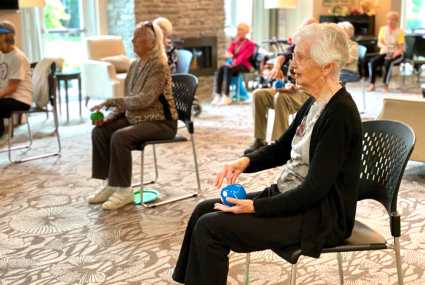Since the pandemic declaration in mid-March, staying at home has been deemed the safest way to avoid community transmission of infection by COVID-19. “Stay home, stay safe,” we have been reminded countless times. Yet while many define home as a detached or single dwelling, an apartment or condo where they live alone or with their immediate family group, many thousands of seniors in BC are living closely together in independent, assisted or long term care homes and being diligently looked after by private operators. And while there have been tragic challenges in care at some licenced long term care communities, it needs to be said that, in most cases, living communally and “staying safe” are not at odds when it comes to protecting the health and wellbeing of vulnerable seniors.
Communal Living — Safe At Home Together
The reality of living communally is that, for most residents in the hundreds of private seniors homes in BC, it has provided the best and safest life within the context of being “locked-in” and isolated from the loving care and attention of family members. Even at a distance of six feet, hospitality and care teams as well as friends and neighbours from adjoining rooms can provide companionship. Recreation teams engage seniors in physical and social activities that keep them involved and active, even if residents cannot leave the site. And hospitality, service and care teams support and protect their physical health by providing 5 star meals and rigorous hygiene protocols based on an extensive range of oversight systems.
The Language of Senior Living
Let’s just make sure we’re all on the same page when it comes to understanding the ins and outs of seniors housing. There are three essential levels. Independent living residences provide accommodation where seniors are free to come and go as they please. Most offer a range of amenities, from meals and recreation to transportation and wellness clinics. Independent senior living residences are not publicly funded, nor do they require provincial licensing, but the majority have well-developed internal quality improvement programs and voluntarily subscribe to independent assessments by the BC Seniors Living Association.
The second level of housing is assisted living, which includes accommodations as well as some amenities. Seniors living in these residences also receive varying levels of support including personal care and medication assistance. Thirdly, long term care homes are for seniors requiring a much broader scope of health care services, much of it offered on-site. And many seniors living providers offer multiple levels of accomodation, services and care under one roof, providing for ageing in place.
Care Provider Clarity
When it comes to who provides seniors housing and care services, the list includes public health authorities, for-profit, and not-for-profit companies that are funded by the province to offer publicly subsidized housing and care. There are also for-profit and not-for-profit companies that own and operate privately run communities, some of which may have partial or no public funding. Approximately one third of long term care services are provided by public health authorities, the rest are either contracted out to for-profit and not-for-profit providers, or are private-pay and operated by not-for-profit and for-profit providers. The communities these providers operate deliver housing and care at the levels of assisted and long term care and all are regulated and/or licensed.
Private Pay Puts You First
A private, BC-owned for-profit operator, Bria Communities has a family of Lower Mainland residences that provide for independent living as well as licensed long term care. As is the case with all private operators, seniors who choose to make Bria Communities their new home are fortunate enough to be able to personally fund the expense. This means that they have the freedom and flexibility to choose who will be providing these services to them. It also means that there is even more incentive to ensure delivery of the highest quality of services and care and avoid short cuts or quick fixes, as we work to earn and maintain our residents’ trust and the trust of their family members.
It’s clear that BC’s seniors want the choice of living in communities that support their desired lifestyle while meeting their changing needs through this complex stage of life. Private operators like Bria provide seniors with housing, hospitality and care options that address those needs at the same time as safeguarding their health and wellbeing. Since the start of the pandemic, the vast majority of private operators have met the challenges of evolving directives from our provincial health and regulatory partners based on rapidly accumulating epidemiological data. And we’re doing this during a public health crisis the scale of which has not been seen during our lifetimes.
The Choice to Create Safe Seniors Communities
Providing services in this sector is our choice. We think that looking after seniors is a privilege. They inspire us with their strength, their calm and their quiet courage. Our hearts go out to those suffering the devastating impacts of the loss of so many seniors around the world. Yet this only re-emphasizes the importance of safeguarding residents’ safety and wellbeing through our community sites and maximizing the care we provide to those who live here. And together we’re all making the best of a situation we’d prefer to not be going through, living and working together, diligently striving to stay safe and “stay home” communally in seniors living communities.

Comments